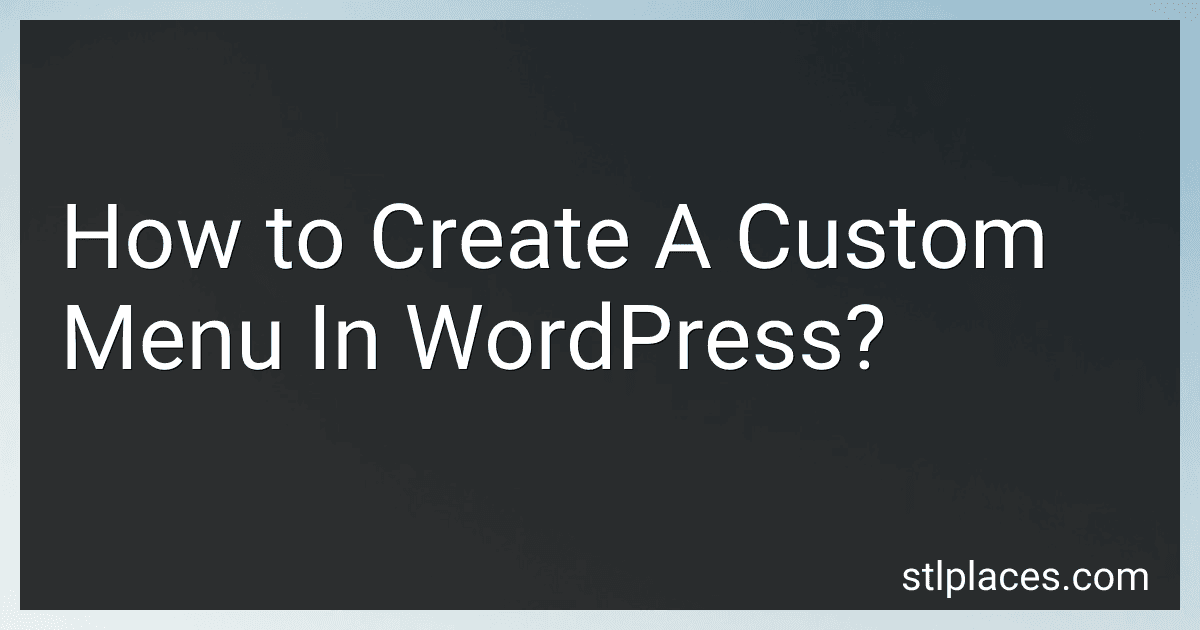Best WordPress Menu Plugins to Buy in December 2025
To create a custom menu in WordPress, follow these steps:
- Log in to your WordPress dashboard.
- Go to the Appearance option in the left-hand sidebar and click on Menus. This will open the Menu Editor.
- Start by giving your menu a name in the "Menu Name" field. This name is for your reference and will not be visible on the website.
- Next, select the pages or posts you want to add to your menu from the left-hand column. You can use the checkboxes to select multiple items.
- Once you have selected the items, click on the "Add to Menu" button. They will then appear in the right-hand column.
- You can rearrange the order of the menu items by dragging and dropping them into the desired position.
- To create sub-menu items or dropdowns, drag and indent the items below the parent item. This will display them as sub-items when the menu is displayed on your website.
- Customize the menu item labels by clicking on the arrow icon next to each item. Here you can change the navigation label, title attribute, and add a CSS class.
- To add external links to your menu, click on the "Custom Links" section on the left and enter the URL and label for the link.
- In the "Menu Settings" section, you can assign the menu to a specific location, such as the primary navigation area or a custom navigation menu widget.
- After making all the desired changes, click on the "Save Menu" button to save your custom menu.
Once saved, your custom menu will be displayed on your WordPress website according to the theme's design and location you selected.
How to access the WordPress menu editor?
To access the WordPress menu editor, follow these steps:
- Log in to your WordPress dashboard.
- Click on "Appearance" in the left-hand sidebar.
- From the dropdown menu, click on "Menus".
- The Menu Editor page will open, displaying the available menus.
- If you want to edit an existing menu, select it from the dropdown list and click on the "Select" button.
- If you want to create a new menu, enter a name for the menu in the "Menu Name" field and click on the "Create Menu" button.
- The Menu Editor will now show a list of pages, posts, categories, and custom links that you can add to your menu.
- To add an item to the menu, select it from the appropriate section (e.g., "Pages" or "Categories") and click on the "Add to Menu" button. You can reorder the items by dragging and dropping them accordingly.
- To create sub-menus, drag an item under and slightly to the right of another item until it indents.
- To remove an item from the menu, click on the arrow icon to expand its details, and then click on the "Remove" link.
- After making changes to the menu, click on the "Save Menu" button to apply the changes to your website.
That's it! You have successfully accessed and used the WordPress menu editor.
What are sticky menus in WordPress?
Sticky menus in WordPress refer to navigation menus that remain fixed at the top of the screen even when the user scrolls down the page. The sticky menu feature enhances website navigation by providing constant access to important links and menus, regardless of the user's position on the page. This ensures easy and convenient navigation throughout the website. Sticky menus are often used to improve user experience and can be implemented using various WordPress plugins or by incorporating custom code into the theme.
What is a social media menu in WordPress?
A social media menu in WordPress is a feature that allows users to display links to their various social media profiles on their WordPress website. It typically appears as a menu bar or a floating sidebar on the website, and contains icons or buttons with links to the related social media platforms, such as Facebook, Twitter, Instagram, LinkedIn, etc.
By adding a social media menu to their WordPress website, users can encourage visitors to connect with them on social media and increase their social media presence. It provides an easy and convenient way for website visitors to navigate to their social media profiles and engage with their content outside of the website.
How to change the color of a menu item in WordPress?
To change the color of a menu item in WordPress, you can follow these steps:
- Login to your WordPress admin area.
- Go to the "Appearance" tab and click on "Customize".
- In the customization panel, select "Menus".
- Choose the menu you want to modify from the list of available menus.
- Click on the menu item you wish to change the color of.
- Look for an option labeled "Color" or "Background Color". The specific label may vary depending on your theme.
- Click on the color picker or enter a specific color code to select the desired color.
- Preview the changes and save them once you're satisfied.
Note: The terminology and options may differ slightly depending on the theme you are using. If you can't find the specific options mentioned, you can check for similar options related to menu item customization or consult the theme's documentation for more guidance.
How to add an icon to a custom menu item in WordPress?
To add an icon to a custom menu item in WordPress, you can follow these steps:
- Install and activate a plugin called "Menu Icons" from the WordPress plugin repository. This plugin allows you to add icons to your menu items easily.
- After activating the plugin, go to Appearance > Menus in your WordPress dashboard.
- In the Menu Editor, you will see a new "Icon" field for each menu item. Click on the menu item you want to add an icon to.
- In the "Icon" field, you can either manually enter the class name of the icon you want to use or click on the "Select Icon" button to choose from a list of available icons.
- If you choose to manually enter the class name, you can find the class names for popular icon libraries like FontAwesome or Dashicons by searching on their respective websites.
- Once you have entered the class name or selected an icon, click on the "Save Menu" button to save your changes.
- Now, view your website, and you should see the custom menu item with the added icon.
Please note that the availability of icons may vary depending on the plugin you use and the icon libraries it supports.





